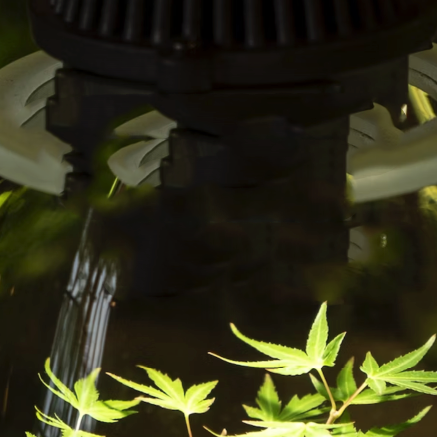As we enter the summer, the mere mention of the word 'pythium' is all takes to generate serious anxiety, especially among growers running active hydroponic systems. The long, hot days are great for beer gardens, but not so great for your indoor plants...
The term "hydroponics" derives from the combination of two Greek words: 'hydro', meaning water, and 'ponos', meaning labour. Therefore, it literally translates to "water-working." Hydroponics involves a range of methods that use oxygenated water instead of soil, along with a specialized medium like clay pebbles. Typically, a sizable reservoir is required to store nutrient solutions, which can sustain plants for an entire week. The temperature levels in the surrounding area can affect these reservoirs. As the weather gets warmer, the nutrient solution also gets warmer. When the nutrient solution exceeds the ideal temperature range of 18-21C (65-70F), two things can occur:
Firstly, warm temperatures can lead to reduced levels of oxygen in the water or nutrient solution stored in the reservoir. This is counterintuitive, as liquids typically dissolve more substances as they get warmer, but this isn't the case with oxygen. As the solution gets warmer, less oxygen is able to dissolve in it. This can be problematic for plant growth, as roots require oxygen to thrive. A lack of dissolved oxygen in warm nutrient solution can slow root growth, ultimately impacting the entire plant.
Furthermore, low oxygen levels in the solution can also promote the growth of anaerobic pathogens. As a general rule, beneficial microbes are aerobic, meaning they require oxygen to survive, while harmful microbes are anaerobic, meaning they can grow without oxygen. As the temperature in the reservoir increases, conditions become more favourable for the growth of harmful microbes, which exacerbates the next issue...
Secondly, warm and humid conditions in the reservoir can encourage the growth of the fungus Pythium, which causes root rot. Pythium thrives in environments with high moisture levels and low dissolved oxygen, making warm reservoir tanks during summer the perfect breeding ground for the ultimate scourge of the hydroponic farmer.
Once pythium has taken hold of a system, it can completely ruin every plant growing in it, and it can do so over a very short space of time (within just a few days). If you've ever pulled a struggling plant out and found a pathetic, sludgy root system, then you know the problem that we're talking about!
On top of that, pythium can be an absolute nightmare to get rid of as there are few treatments out there that can actually kill the fungus, and even fewer that won’t kill your plants. So, what should the concerned gardener do to get some sleep at night?
The very first step is to ensure that the reservoir is located in the coolest place possible. Make sure it is well out of the way of hot HPS lamps (preferably in a different room) and direct sunshine. The outside of the reservoir can also be insulated to help keep the heat out.
Another solution to the problem of warm nutrient solutions is a water chiller. This device is connected to the reservoir via flexi pipes. Nutrient is pumped from the tank, through the chiller (where it gets cooled), and back out the other side. This maintains the nutrient temperature at your chosen setting - the ideal being around 18°C (65° F).
Chilling the nutrient solution increases the dissolved oxygen content, which is essential for healthy plant growth. An air stone placed at the bottom of the reservoir can further increase oxygen levels while keeping the solution well-mixed. In our opinion, every reservoir should be equipped with an air stone, as it provides numerous benefits for plant growth and overall reservoir health.
The third step is to use a preventative product:
Pythoff has been around for years. It disappeared for a short while but now it is back. It’s an old favourite that prevents and treats pythium infections, keeping your hydroponics system sterile. Pythoff should be added at every weekly reservoir change on a continuous basis, for on-going protection. Add at the rate of 2ml per litre.
House & Garden’s Roots Excelurator is one of our all-time favourite products. This remarkable liquid is a true wonder product for hydroponic growers. Roots Excelurator coats the roots of plants with a fine membrane that allows for the free passage of nutrients and oxygen, while acting as an incredibly effective barrier against pythium spores attempting to infiltrate the roots. It has even been rumoured that Roots Excelurator can eradicate pythium from an infected hydroponic system, although we have not personally tested this claim.
In addition to its pythium protection benefits, Roots Excelurator also stimulates root growth without harming beneficial microbes in the root-zone. As roots are the engine of a plant, this sets up the perfect conditions for a bountiful harvest. We recommend adding Roots Excelurator at every weekly reservoir change on a continuous basis for ongoing root protection.
Silver Bullet Roots is a highly effective solution to root diseases. Traditional peroxide treatments added to a reservoir tank lose their potency quickly. Silver Bullet Roots, however, has been chemically enhanced by combining it with silver. The silver component prolongs the effective active life of the peroxide to around five weeks.
Silver Bullet Roots can tackle all types of pathogenic microbes, including algae, spores, protozoa, and viruses. The silver component not only extends the active life of the peroxide, but also breaks down the defences of certain resistant bacteria and eliminates any biofilms where microbes can thrive. Additionally, there's a spray version called Silver Bullet Mist that is perfect for cleaning and disinfecting your equipment.

